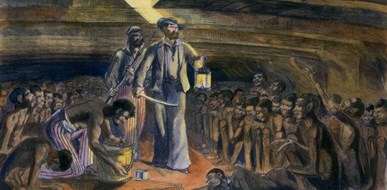Legal Aspects of Jewish Slavery Law in Eighteenth-Century Amsterdam
Published 1 April 2019by Yehonatan Elazar-DeMota

Overall, dominium in the Roman civil context simply meant ‘man’s total control over his physical world—his land, his slaves or his money.’ © Shutterstock
The study of an 18th-century Jewish legal journal published in Amsterdam sheds light on the complex slave ownership issues. The legal notion of dominium is well-known for those familiar with Roman law: it implies dominion, control, ownership, and sovereignty. Yet as with much Roman legacy, the term did not cease to exist after the end of the Roman times.
The rabbinic scholars at the seminary of Etz Ḥaim of Amsterdam produced a journal of legal responsa called Peri Etz Ḥaim, which spanned from the seventeenth to the eighteenth centuries. The journal, which addressed rabbis from the Netherlands and abroad, serves as a great source for those seeking to analyse slavery and slave trading in the Western Sephardic legal thought. One can find cases where people are treated as property.
Slavery as a concept and a practice
Traditionally, Jewish religious scholarship distinguished between two types of slavery during the Biblical period: Hebrew slavery and Canaanite slavery. Canaanite slavery refers to those non-Hebrew slaves, which were held captive as prisoners of war. To draw a legal comparison, Biblical Canaanite slavery can be equated to servitus in ius gentium [slavery according to the Law of nations] in Roman law. The other type of slavery—Hebrew slavery—as the name itself implies, was an arrangement in which an impoverished Israelite would work for another Israelite for a period of 6 years, then would go free with accumulated wealth at the beginning of the 7th year [Indentured servitude]. However, it became virtually obsolete after the devastation of the first Israelite commonwealth [c. 6 BCE]. During the second Jewish commonwealth, while under Roman occupation [c. 2 CE], jurists focusing on slavery issues had to grapple with the limits of using only one term - ‘Canaanite’ slavery, as defined in the Talmud [the body of Jewish civil and ceremonial law and legend]. Whereas during the Biblical period, the term was applied to ethnic Canaanites, during the second Jewish commonwealth, any non-Jewish person who became a slave of a Jew was considered a ‘Canaanite slave.’ Under this dispensation, the owner had to see that his slave voluntarily accepted the Jewish precepts and joined the Hebrew Nation. If the slave did not accept such an agreement, the owner was obligated to sell him to non-Jews. On the other hand, the Biblical precept states:
Moreover of the children of the strangers that do sojourn among you, from them may ye buy, and of their families that are with you, which they have begotten in your land; and they may be your possession. And ye may make them an inheritance for your children after you, to hold for a possession: of them may ye take your bondmen forever; but over your brethren the children of Israel ye shall not rule, one over another, with rigor [Leviticus 25:45-46].
During the Biblical period, there were no manumissions (freeing) for Canaanite slaves. However, later years saw a change in the practice of freeing slaves: in fact, during the period of Talmudic legislation, manumission of non-Jewish slaves resulted in their naturalisation to the Jewish People. This shows that the notion of ‘Canaanite slavery’ underwent a change in meaning and understanding between the first and second Jewish commonwealths, whereby non-Jewish persons became naturalised citizens of the Hebrew Nation through the institution of slavery.
Who owns? Atlantic Slave Trade in the Jewish Amsterdam
As the Nação [Hebrews of the Portuguese Nation] became more active in the Atlantic Slave Trade, the practices changed once more. The number of manumissions became more limited, and the community leaders had the right to permit it or not. More specifically, to understand the workings of this policy better, we can take a look at a very concrete example from the Peri Etz Ḥaim journal. It involves a slave owner who lives in the Land of Israel, who sends his female slave to his brother so that he could set her free. The slave owner addresses his concern to the Amsterdam rabbi, David son of Raphael Meldola in 1767:
Reuben lives in Sippori and owns a “Canaanite” maidservant—He bought her according to the law of land. After a time, she expresses to her master that she wants to become a Jewess. Due to difficulties with this, he sends her away as a gift to his brother Shimeon that lives in Tiberias. He sends her with a note, stipulating that he take care of the details to free her as a Jewess. Upon receiving the letter, Shimeon replies, “I don’t know if you heard, but one who frees his slaves violates a positive precept, i.e. you shall make them serve you forever.” He continues saying that the manumission of slaves does not apply at the present moment, therefore, he desists. The first brother replies and tells him not to violate the positive precept of the Torah. Since Shimeon knows the Scriptures, he decides to return the slave to Reuben, however, gives her to Levi as a gift. How was he allowed to do so if he did not have full ownership of the slave to be able to give her to Levi? Rabbi David Meldola explains that Shimeon never gained full ownership of the slave because he did not accept the original stipulation to free her, therefore, Reuben remains the owner and can do with her as he pleases. [Peri Etz Ḥaim, Vol. 5, 227-231]
The extract above illustrates how prevalent the notion of treating slaves as property was. Indeed, the ruling on this case depends entirely on whether Reuben or Shimeon have ownership rights of the woman in order to make a legal transaction with her.
Let’s go back to the Roman law which was discussed earlier in this blog post to untangle this example better. In Roman law, dominium relates an owner with his property. In addition, the Romans also had a concept of mastery, power over persons or things, expressed by the same word dominium. Overall, dominium in the Roman civil context simply meant ‘man’s total control over his physical world—his land, his slaves or his money.’ Utilising this legal concept, albeit in rabbinic Hebrew jargon, Rabbi Meldola explains in this responsum that it is not clear whether Reuben gave Shimeon a legal document stipulating that he should free her. In Jewish law, legal transactions involving the exchange of property require a written document. Either way, Meldola rules that Shimeon never accepted the terms of the contract, therefore, Reuben remains the legitimate owner of the slave woman. This case reveals that the Peri Etz Ḥaim journal serves as an excellent tool in analysing the legal parameters and practices of the Nação in Amsterdam and abroad in the early modern era.

